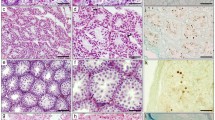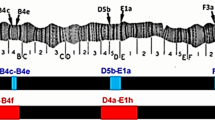Abstract
Interspecific F1 hybrid females of D. serido and D. buzzatii are fertile, but hybrid males are sterile. By successive backcrossing of hybrid females to D. buzzatii males it is possible to diminish the genomic contribution of D. serido to the hybrid karyotype. Finally, only selected chromosome sections of D. serido known as inversions restricted to this species were individually left in the otherwise D. buzzatii karyotype, namely: 2 C2b-F4a (j9m9n9), 2 B2c-F4a (j9k9), 3 C5a-G1b (k2), 4 E2a-G2f (m) and 5 C5d-F2h (w). The present paper deals with the influence of these chromosome sections on sperm differentiation. Any of them produces hybrid male sterility in heterozygous condition. We analyzed spermiogenesis using the DNA specific fluorescence dye BAO in hybrid males which were heterozygous either for only one inversion, as in chromosomes 3, 4 and 5, or for a series of inversions on the same chromosome, as in chromosome 2. The abnormalities recorded included abnormal formation of the cysts, lower than normal number of cysts, abnormal number of nuclei per cyst, incomplete elongation of the cyst, incomplete elongation of the nuclei, displacement of the nuclei from the head region of the cyst and lack of individualization. In no case was there any contents in the seminal vesicle. The section from chromosome 2 of D. serido had the most drastic effect; the disruption produced by the chromosome section corresponding to inversion 3 k2 was only a little more severe than that due to 5 w, and both may be distinguished only quantitatively; inversion 4 m produced the slightest deviation from normal spermiogenesis. The larger the serido section introduced in the hybrid, the more severe were the abnormalities it produced. An interpretation in terms of a balance genic theory on the functioning of the genetic system is given.
Similar content being viewed by others
References
Baimai, V., Sene, M. M. & Pereira, M. A. Q. R., 1983. Heterochromatin and karyotypic differentiation of some neotropical cactus breeding species of the Drosophila leta species group. Genetica 60: 81–92.
Bridges, C. B., 1922. The origin of variation in sexual and sex-limited characters. Am. Nat. 56: 51–63.
David, J., 1959. Étude quantitative du développement de la Drosophile élevéc en milieu axénique. Bull. biol. Fr. Belg. 93: 472–505.
Dobzhansky, T., 1934. Studies on hybrid sterillity. I. Spermatogenesis in pure and hybrid Drosophila pseudoobscura. Z. Zellforsch. mikrosk. Anat. 21: 169–223.
Dobzhansky, T., 1936. Studies on hybrid sterility. II. localization of sterility factors in Drosophila pseudoobscura hybrids. Genetics 21: 113–135.
Dobzhansky, T., 1970. Genetics of the evolutionary process. Columbia Univ. Press New York.
Dobzhansky, T. & Tan, C. C., 1936. Studies on hybrid sterility. III. A comparison of the gene arrangement in two species, Drosophila pseudoobscura and D. miranda. Z. indukt. Abstamm,-VererblLehre 72: 88–114.
Dobzhansky, T. & Beadle, G. W., 1936. Studies on hybrid sterility. IV. Transplanted testes in Drosophila pseudoobscura. Geneties 21: 832–840.
Evgenev, M. B., 1971. The pattern of polytene chromosome coanjugation and crossing-over in interspecific hybrids of Drosophila. Theoret. appl. Genetics 41: 249–254.
Goldschmidt, R. B., 1940. The material basis of evolution. Yale Univ. Press. New Haven.
Goldschmidt, R. B., 1955. Theoretical geneties. Univ. of California Press, Berkeley & Los Angeles.
Hauschteck-Jungen, E. & Maurer, B., 1976. Sperm dysfunction in sex-ratio males of Drosophila subobscura. Genetica 46: 459–477.
Kerkis, J., 1933. Development of gonads in hybrids between Drosophila melanogaster and D. simulans. J. exp. Zool. 66: 477–509.
Laugé, G., 1980. Sex determination In: M.Ashburner & T. R. F.Wright (eds), The geneties and biology of Drosophila, Vol. 2d. Academic Press, London.
Lindsley, D. L. & Tokuyasu, K. T., 1980. Spermatogenesis. In: M.Ashburner & T. R. F.Wright (eds), The genetics and biology of Drosophila, Vol. 2d. Academic Press, London.
MacGregor, H. C., 1982. Big chromosomes and speciation amongst Amphibia. In: G. A.Dover & R. B.Flavell (eds), Genome evolution. Academic Press, London.
Mainland, G. B., 1942. Genetic relationships in the Drosophila funebris group. Univ. Texas Publ. 4228: 74–112.
Moran, Ch., 1981. Spermatogenesis in natural and experimental hybrids between chromosomally differentiated taxa of Caledia captiva. Chromosoma 81: 579–591.
Patterson, J. T., Brown, M. S. & Stone, W. S., 1940. Experimentally produced aneuploidy involving autosomes of Drosophila melanogaster. Univ. Texas Publ. 4032: 167–189.
Patterson, J. T. & Stone, W. S., 1952. Evolution in the genus Drosophila. Macmillan, New York.
Ruch, F., 1972. Principles and some applications of cytofluorometry In: G. L.Wied & G. F.Bahr (eds), Introduction to quantitative cytochemistry. II. Academic Press, New York & London.
Ruiz, A., Fontdevila, A. & Wasserman, M., 1982. The evolutionary history of D. buzzatii. III. Cytogenetic relationships between two sibling species of the buzzatii cluster. Genetics 101: 503–518.
Schäfer, U., 1978. Sterility in Drosophila hydei x D. neohydei hybrids. Genetica 49: 205–214.
Stone, W. S., 1947. Gene replacement in the virillis group. Univ. Texas Publ. 4720: 161–166.
Wasserman, M., 1962. Cytological studies of the repleta group of the genus Drosophila. V. The mulleri subgroup. Univ. Texas Publ. 6205: 85–118.
Wasserman, M., 1982. The repleta species group. In: M.Ashburner, H. L.Carson & J. N.ThompsonJr. (eds), The genetics and biology of Drosophila. Vol. 3b. Academic Press, London.
Wharton, L. T., 1942. Analysis of the repleta group of Drosophila. Univ. Texas Publ. 4228: 23–53.
Wharton, L. T., 1943. Analysis of the metaphase and salivary chromosome morphology within the genus Drosophila. Univ. of Texas Publ. 4313: 282–319.
White, M. J. D., 1973. Animal cytology and evolution. 3rd Ed. Cambridge Univ. Press. Cambridge.
Author information
Authors and Affiliations
Additional information
This is paper No. VII in the series ‘The evolutionary history of Drosophila buzzatii.
Rights and permissions
About this article
Cite this article
Naveira, H., Hauschteck-Jungen, E. & Fontdevila, A. Spermiogenesis of inversion heterozygotes in backcross hybrids between Drosophila buzzatii and D. serido . Genetica 65, 205–214 (1984). https://doi.org/10.1007/BF00122907
Received:
Accepted:
Issue Date:
DOI: https://doi.org/10.1007/BF00122907




